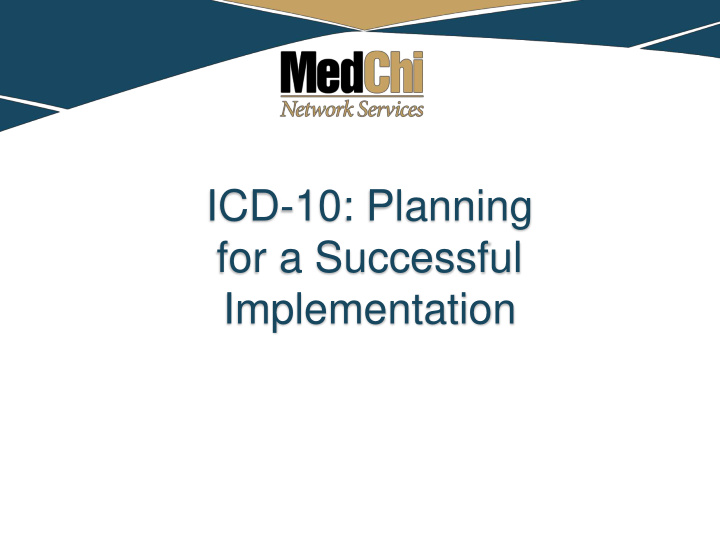



ICD-10: Planning for a Successful Implementation
Contents 1. Introduction to ICD-10 2. Implementation Calendar 3. Getting Ready 4. Preparation Checklist 5. Resources 1
What is ICD-10? 10 th revision of the International Classification of Diseases (ICD) method of coding: ◦ The patient’s state of health, and ◦ Institutional procedures Allows for: ◦ More information per code ◦ Better support for care management and quality ◦ Improved ability to understand risk and severity 2
Transition Facts All HIPAA-covered entities must use new code sets as of October 1, 2015 CPT coding is not affected by the transition ICD-10 CM/PCS consists of: ◦ ICD-10-CM for diagnosis coding ◦ ICD-10-PCS for inpatient procedural coding 3
Diagnosis Coding Captures more specific data from clinical documentation: left side v. right side, initial v. subsequent encounter, routine v. delayed healing 4
Structure Changes 5
Side-by-Side 6
7
Quarterly Calendar Quarter 1: Technical Preparedness ◦ EHR system updates, Meaningful Use, CRISP Quarter 2: Back Office Preparedness ◦ Staff training, vendor contact, A/R cleanup, coding review, financial planning Quarter 3: Full Practice Readiness ◦ Implement new tools, review physician and staff roles, testing Quarter 4: Implementation and Revenue Cycle Management ◦ Claims accuracy, payment processing, monitoring KPIs 8
Project Plan Develop a comprehensive plan to govern the transition process All personnel must be aware of the extent of this change Assign clear responsibility for each step Develop a comprehensive, realistic budget Involve all stakeholders (physicians, vendors, payers, clearinghouses) Include a transition timeline and adhere to it 9
Sample Template from the AMA 10
Transition Checklist Identify current systems/structure/processes that use ICD-9 codes Contact all EHR/PM vendors about updates and testing Develop implementation plans with billing service and clearinghouse Talk to payers about transition and potential contract changes Review changes to workflow Assess training needs Budget for time and costs; consider ways to mitigate financial risk Conduct full end-to-end testing 11
Impact Assessment Analyze how codes are used throughout the practice ◦ Billing/submitting claims, eligibility checks, referrals Identify commonly used ICD-9 codes and explore related ICD-10 codes Identify paper and electronic forms to accommodate new structure 12
Systems Update Contact Vendors ◦ EHR/PM systems should be updated and support may be available ◦ Clearing house and/or billing service will need to be reviewed Complete Systems Tests ◦ Internal and external once all updates are installed 13
Minimizing Challenges Eliminate coding backlogs prior to Oct 1, 2015 Prioritize medical records for coding Provide refresher training ◦ ICD-10 accuracy ◦ Practice workflows and new efficiencies Pre-determine steps for addressing errors and vendor issues 14
Resources MedChi Network Services ◦ info@medchiservices.org or 888-507-6024 Centers for Medicare and Medicaid Services ◦ cms.gov/ICD10 Maryland DHMH ◦ dhmh.maryland.gov/icd10info American Medical Association ◦ ama-assn.org/go/icd-10 Specialty Societies Payors Vendors 15
Questions? Colleen George 888-507-6024 (phone) Practice Services 888-507-6034 (fax) Administrator cgeorge@medchi.org MedChi Network Services 16
References American Medical Association: The Current State of ICD-10 & Preparing for It ◦ http://www.ama-assn.org/ama/pub/physician- resources/solutions-managing-your- practice/coding-billing-insurance/hipaahealth- insurance-portability-accountability- act/transaction-code-set-standards/icd10-code- set.page Centers for Medicare and Medicaid Services: ICD-10 ◦ cms.gov/ICD10 Department of Health and Mental Hygiene, ICD-10 Transition ◦ https://mmcp.dhmh.maryland.gov/SitePages/ICD -10%20Conversion.aspx 17
Recommend
More recommend